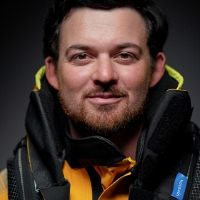AQP Blog
The cold wet Pacific Ocean
Unlike the Northern Atlantic, in which the Gulf Stream continues onto Western Shores of the UK, the Kuroshio current does not stretch across the 3000nm miles of North Pacific, despite Japan's best efforts to point it in the right direction. And so, the sea here in springtime is cold, and the dew point low. Any moist air hits it’s dew point and low-level clouds mist the horizon. It is not immediately obvious to those writing in the log on an hourly basis how good the visibility actually is. The facts are only grounded when we cross a lonesome cargo ship.
To start the watch, I radioed a nearby cargo ship out of curiosity and companionship. They were one hour behind us in local time, heading to Seattle, and will arrive a couple of days before us. Then, they will cross this vast ocean again after two weeks in port. I have a great appreciation for those working on the ships. It is a long time away from home, minimally manned, and a quite reclusive life, bringing their small sub-culture around the world. They say that when the summer comes the fog is burnt off and the voyage is more beautiful.
Physiologically, sailing in low visibility and softer light compared to the direct hot-lamp heat of the Equator, we become more contemplative. Asking questions like 'why am I here?' not on the earth, but in this particular cold, wet bit of the Earth.
Today we saw a halo-ed sun and tonight we can see the hazy stars above our heads. Since there are no points of reference, the compass becomes an old friend to the helm. Electronic instruments, despite their best efforts, are either too slow from dampening, being averaged out for a couple of seconds, or too haywire from instantaneous readings. Sea state affects the electronic true course dramatically as the boat slides non-linearly. The slower the yacht the more it wallows (moves up and down) and the greater the variation, compared to when it tracks (holds course). My biggest fear in ocean racing is being windholed in sea state, a noisy wallowy mess.
The cold moist Pacific air sucks energy away from the body quicker than cold dry air. Something to do with specific heat capacities and the rate of heat transfer between the two media. Another negative to a wetter climate is the risk of base layer and mid-layer getting wet and reducing their insulative properties. The Ocean Sleepwear sleeping bags, buffalo jackets made with pile fibre and Musto mid-layers made with Primaloft are warm despite the dampness. The cold moist air causes condensation on the ceilings and walls that drips and runs, in the galley steam is opaque and we all have dragon’s breath in the morning sunlight. The hardest parts or the body to keep warm are the hands and feet. some you use hot water bottles, other times, hand warmers. Only a good sleeping bag can get them back to normal though. Luckily for us we have had one of the driest ocean crossings of this race series.
A Haiku to finish, Helped by Mull and Rum watch
Crashing over waves,
Under the night sky we see,
Milk way and moon wax.
Tom

